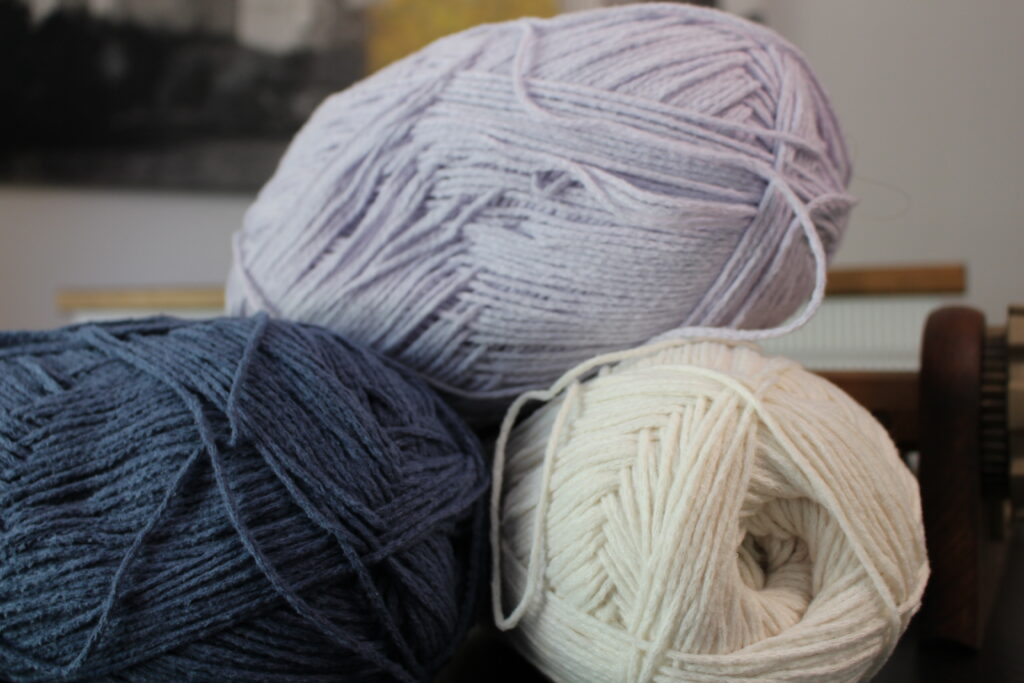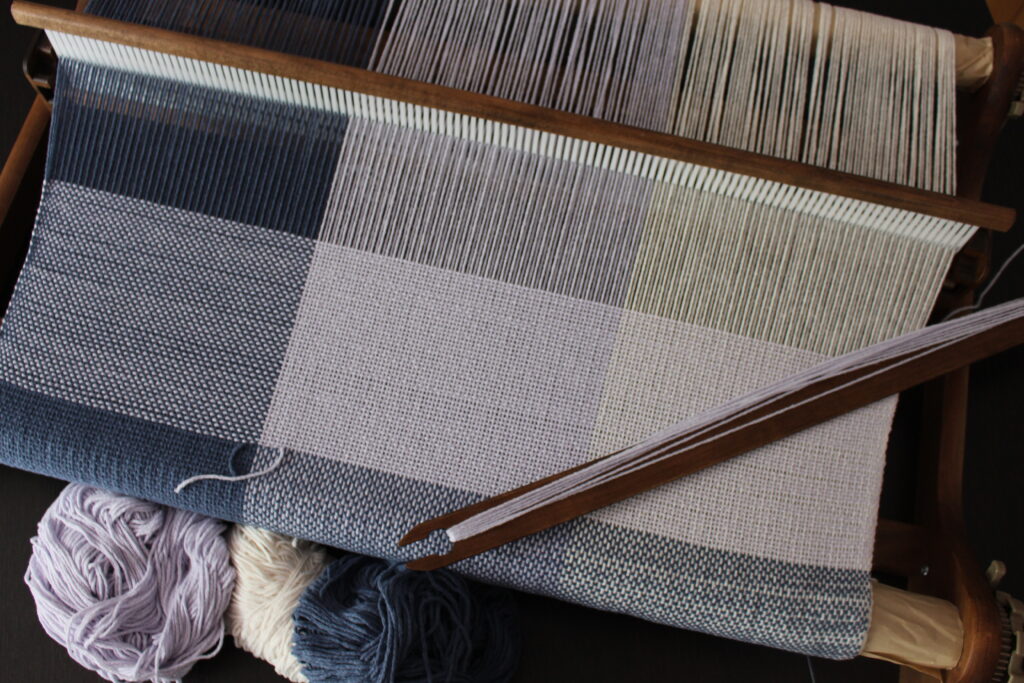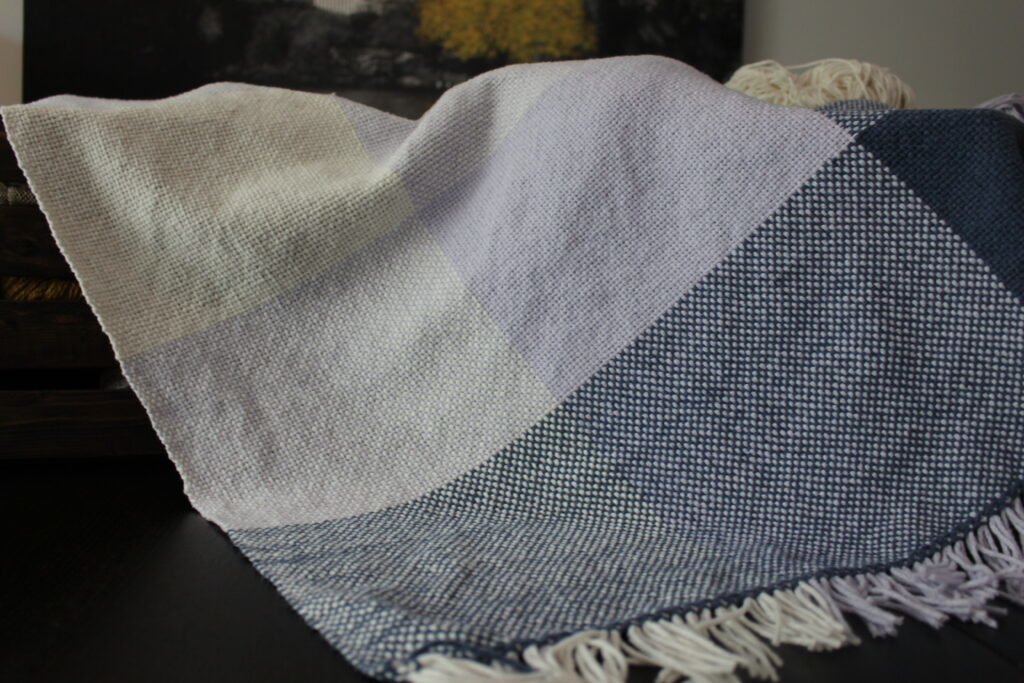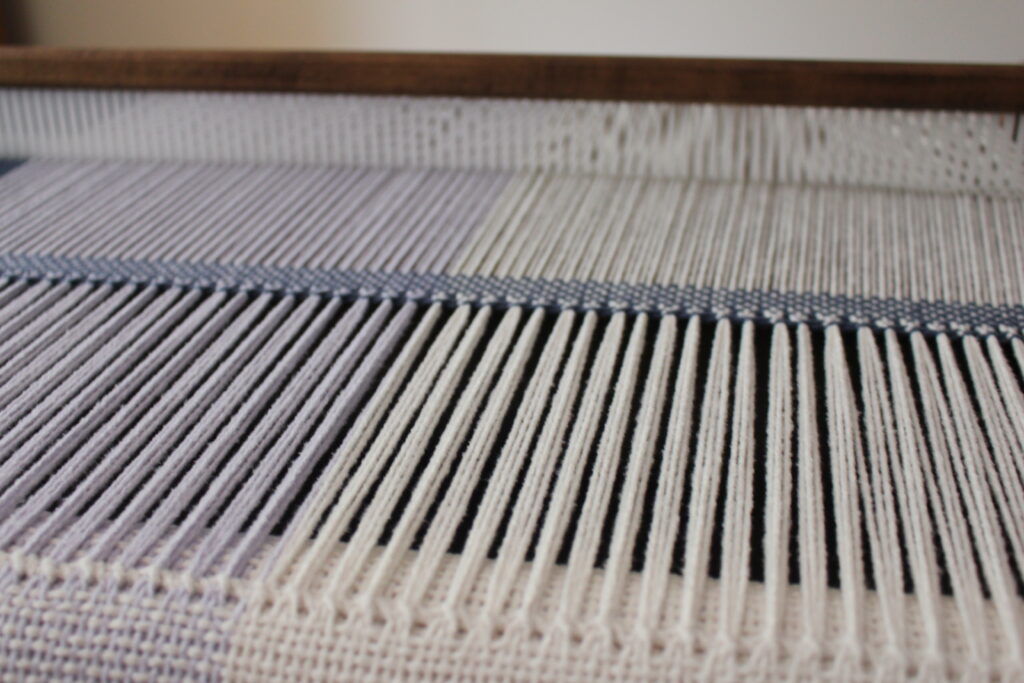Weaving two Baby Blankets with the Same Warp
In today’s project, I am weaving not only one, but two baby blankets with one warp! It’s amazing how many creative possibilities we have in weaving! Also, it’s much more efficient to weave more than one project with the same warp. It takes so much time to dress a loom, we might as well make it worth its while. In this tutorial, I explain all the pattern details of this project. I also give some hints to facilitate the weaving of those two baby blankets with the same warp.
Disclaimer: Links included on this page might be affiliate links. This means that if you purchase a product or service with the links that I provide, I may receive a commission. Please note that there is no additional charge to you. This helps me keep going and create more tutorials.
The Yarn
On my last trip to the yarn store, I fell in love with some polyester yarn. It was just so soft and the colors were so inspiring. I ended up buying Bernat yarn from their “bundle up” collection. I have to say, I was a bit disappointed when I learned that those were a limited edition. With this being said, there exist other brands of yarn manufacturers that also make polyester yarn that could work great for this project. Here are the exact names of the colors that I chose from Bernat:

-Marshmallow (off-white)
-Lilac
-Beluga (a blueish-gray)
The size of the yarn is medium-4 (worsted weight yarn). One ball contains approximately 478 yards/437m. This will be just enough to make this project.

The Width
I have a 32” (80cm) rigid heddle loom from Ashford and I warped the full width of it. I love the width of my loom because I feel like it’s a great size to weave baby blankets on. Still, I must warn you: the blankets woven in this tutorial might not be wide enough to fit on a baby’s bed. However, I find that they are the perfect size to use on a car seat or to put on the stroller to keep the baby snugged in and warm. In Québec-french we called those kind of blanket “dou-dou” which means “soft-soft”, which is exactly what they are.

This being said, if your loom is narrower or if you want to make a bigger blanket, I believe it would be very easy to adapt the pattern. Indeed, it would be possible to weave panels and sew them together at the end while keeping the gradient effect of the pattern.
If you are interested in looking for rigid heddle looms, here’s the link to the Woolery’s Rigid Heddle Looms page. They have everything you might need to start weaving!
https://woolery.com/weaving/weaving-looms/rigid-heddle-looms.html?aff=214
Heddle size
My polyester yarn is size medium 4 (worsted weight yarn) which means that it fits perfectly in my 7.5 dpi heddle. I singled the warp threads in the heddle, so I got 7.5 end per inch.
The Length
As I am weaving for two blanket, it’s important to carefully calculate the warp. At first, I wanted to weave each blanket for 1.1m (44”). But I changed my mind and I wove for 1.05 (42”) to better fit the weft pattern. This is not a huge difference, but I feel it was important to mention. So I warped for a total of 3m (120”) to make sure I had enough length for both blankets, the waste yarn and the yardage between the two blankets.
I usually have 20 cm of waste at the beginning of the project and 30 cm at the end.
I also planned that I would keep 15cm (6”) unwoven between the two blankets to allow for the fringes. For safety reasons, because those blankets are made for babies, I have decided to only keep 5cm (2”) of fringes.
This all sums up to 2m85, but I rounded it up to have 3m long warp.
The Warp Pattern
The colors of yarn that I chose are very soft and I wanted to keep this softness in the pattern. This is why I decided to do a very simple pattern. Basically, I have three equal stripes in the warp: one of each color. I separated my heddle in three equal parts. Here’s the little calculation behind it.

My heddle is 32” wide and we have already ruled that the project will have an epi of 7.5. This means 32 X 7.5 which makes 240 ends in total. Then, 240 ends separated by 3 colors means 80 ends per colors. I direct warped my loom. This means that I pulled 40 loops of each color. While preparing my heddle, I counted every hole to made sure that I had 40 in each section. I also identified those section with scrap yarn to make sure I knew when to switch colors while warping.
I was aiming for a gradient effect in the pattern. This is why I chose to warp my colors from the darkest to the lightest. Thus, I started with Beluga on the left, then in the middle I warped the Lilac and I finished with the Marshmallow on the right.
The First Blanket
For the first blanket, I wanted to have 3X3 checkers. This means that I would have each color only 3 times in the weft. I wove big rectangles of each of the colors in the same sequence as they appear in the warp. This means that I wove 35cm (14”) of Beluga, then 35cm (14”) of Lilac and finally 35cm (14”) of Marshmallow. I hemstitched both ends and that was it! The aim was to have the same gradient effect in the weft than in the warp.
The Second Blanket
For the second blanket, I still wanted the gradient effect, but I wanted more color changes. I decided to weave smaller sections of each color. In order to make sure that this blanket would be the same length as the first one, I couldn’t weave all section of colors the same length. This is why the beluga section are 23 cm (9”) and the lilac and marshmallow sections are 20 cm (8”). This blanket looks like a 5X3 checkers and its final length on the loom was also 42”.

In order I wove:
-Beluga-23 cm (9”)
-Lilac-20 cm (8”)
-Marshmallow-20 cm (8”)
-Lilac-20 cm (8”)
– Beluga-23 cm (9”)
Transition of blankets
Here’s a few insights on how I transitioned from weaving the first to the second blanket. As soon as I had finished weaving the first blanket, I hemstitched it to secure the ends. Then, I advanced my warp of 15cm (6”). I chose to leave this length between the two blankets to make sure that I had enough for the fringes of both blankets. It was important that I hemstitched the ends of the first blanket before advancing the warp. Otherwise, the fabric would have been rolled on the front beam and it would have been difficult to work around and hem.

Then I wove my first few picks. The two first picks were the hardest to achieved because I had to make sure to place the yarn exactly where I wanted it to be. I had no resistance while beating so I had to be extra careful not to beat the yarn too much. After those few picks, everything returned to normal and I could weave like I typically do. I hemstitched the beginning of the second blanket and I kept on weaving!
Weaving Tips
The polyester yarn I had was really flexible. I could crack the tension by a lot and it would always stretch more. So, when the blankets got of the loom, the tension got off as well and they shrank quite a lot! I wove both blankets for 1.05m (42”) and off the loom, they measured 95cm (38”). The same happened with the width. I started with a width of 80cm (32”) and ended up with 68cm (27”) once off the loom. Still, the shrinkage after wet finishing was minimal.

Also, this was a yarn that was very influenced by the beating. By that I mean that if I beat just a little harder, the yarn could easily pack up in the weft. If that had happened, I would have had a mostly weft face fabric which I did not want. Also, the fabric would have been very stiff and would not have had the nice drape I wanted. I had to be mindful of my beating all the way through the weaving of those two baby blankets on the same warp.